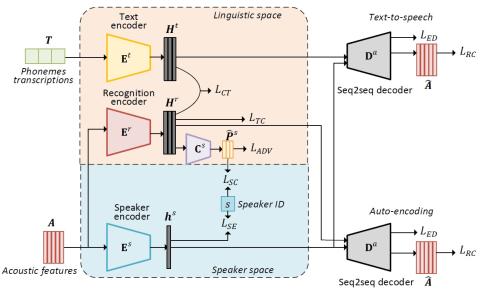This paper presents a method of sequence-to-sequence (seq2seq) voice conversion using non-parallel training data. In this method, disentangled linguistic and speaker representations are extracted from acoustic features, and voice conversion is achieved by preserving the linguistic representations of source utterances while replacing the speaker representations with the target ones. Our model is built under the framework of encoder-decoder neural networks. A recognition encoder is designed to learn the disentangled linguistic representations with two strategies. First, phoneme transcriptions of training data are introduced to provide the references for leaning linguistic representations of audio signals. Second, an adversarial training strategy is employed to further wipe out speaker information from the linguistic representations. Meanwhile, speaker representations are extracted from audio signals by a speaker encoder. The model parameters are estimated by two-stage training, including a pretraining stage using a multi-speaker dataset and a fine-tuning stage using the dataset of a specific conversion pair. Since both the recognition encoder and the decoder for recovering acoustic features are seq2seq neural networks, there are no constrains of frame alignment and frame-by-frame conversion in our proposed method. Experimental results showed that our method obtained higher similarity and naturalness than the best non-parallel voice conversion method in Voice Conversion Challenge 2018. Besides, the performance of our proposed method was closed to the state-of-the-art parallel seq2seq voice conversion method.
Conclusion
In this paper, a non-parallel sequence-to-sequence voice conversion method by learning disentangled linguistic and speaker representations is proposed. The whole model is built under the framework of encoder-decoder neural networks. The strategies of using text inputs and adversarial training are adopted for obtaining disentangled linguistic representations. The model parameters are pre-trained on a multi-speaker dataset and then fine-tuned on the data of a specific conversion pair. Experimental results showed that our proposed method surpassed the non-parallel VC method which achieved the top rank in Voice Conversion Challenge 2018. The performance of our proposed method was close to the state-of-the-art seq2seq-based parallel VC method. Ablation studies confirmed the effectiveness of adversarial training, using text inputs and model pre-training in our proposed method. Investigating the methods of one-shot or few-shot voice conversion by improving the prediction of speaker representations in our proposed method will be our work in future.

